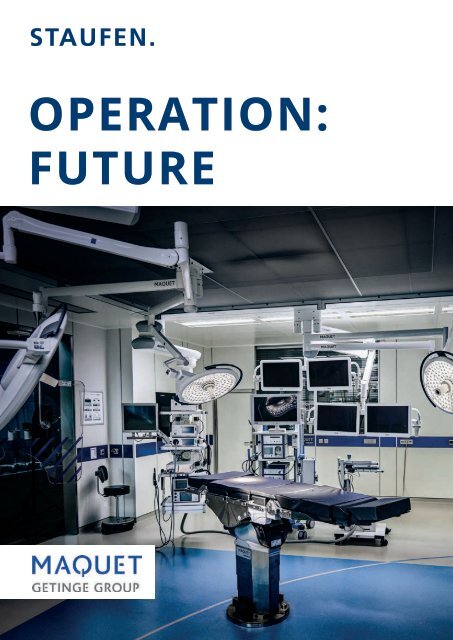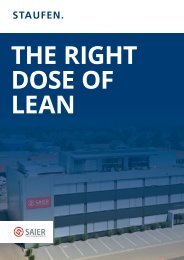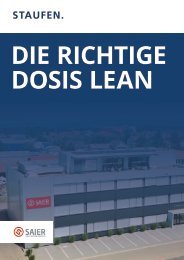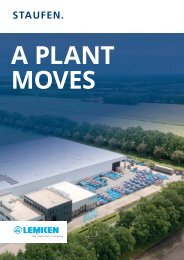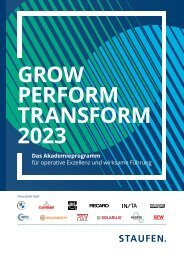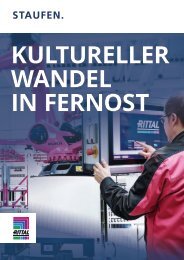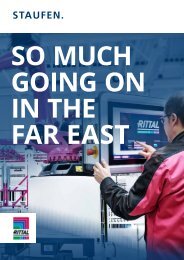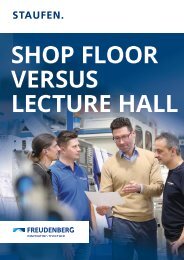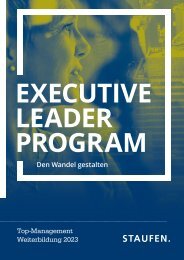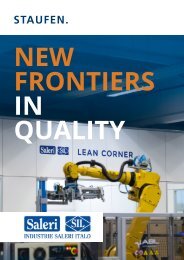Operation: Future : Maquet a Success Story by Staufen AG
The first heart transplantation operation, in 1967, was done on an operation table from Maquet. Roughly 50 years later, Maquet, a daughter company from the Getinge-Group have an ongoing operation themselves to be able to face and succeed the challenges in the future. The goal: still be one of the top players in the medicine engineering market.
The first heart transplantation operation, in 1967, was done on an operation table from Maquet. Roughly 50 years later, Maquet, a daughter company from the Getinge-Group have an ongoing operation themselves to be able to face and succeed the challenges in the future. The goal: still be one of the top players in the medicine engineering market.
Create successful ePaper yourself
Turn your PDF publications into a flip-book with our unique Google optimized e-Paper software.
OPERATION:<br />
FUTURE
STAUFEN. | MAQUET<br />
2<br />
Lean<br />
Transformation<br />
in Rastatt<br />
The first heart transplantation operation, in 1967, was done on<br />
an operation table from <strong>Maquet</strong>. Roughly 50 years later, <strong>Maquet</strong>,<br />
a daughter company from the Getinge-Group have an ongoing<br />
operation themselves to be able to face and succeed the challenges<br />
in the future. The goal: still be one of the top players in the<br />
medicine engineering market.<br />
When <strong>Maquet</strong> was founded in 1838, operations where still held<br />
without anesthesia and in poor sanitary standards. With the medical<br />
evolution, <strong>Maquet</strong> turned from a medium-sized operation table<br />
manufacturer to a market leader in the area of wide-ranging<br />
therapeutic solutions for the hospital sector. Nowadays <strong>Maquet</strong><br />
belongs to the Swedish Getinge Group. <strong>Maquet</strong> turned into one<br />
of the leading companies in the highly growing medicine engineering<br />
branch <strong>by</strong> offering innovative therapy and infrastructure<br />
solutions in acute sectors of hospitals – such as operation rooms,<br />
hybrid op’s/catheter laboratory, ICU (Intensive Care Unit) as well<br />
as patient transportation systems within the hospital.
STAUFEN. | MAQUET<br />
3<br />
An innovative, <strong>by</strong> the employees, designed assembly line according to the lean principles in the factory of Rastatt
STAUFEN. | MAQUET<br />
4<br />
A factory on the test bench<br />
STARTING<br />
POINT<br />
Dark halls with cranes and massive shelf racks. Hidden assembly<br />
boxes as workplaces for employees and a high amount of inventory.<br />
That was the <strong>Maquet</strong> factory in 2014.<br />
Nowadays it is unrecognizable. The halls are light, neat and nearly<br />
clinically clean. The employee’s workplace is, well visible for everyone,<br />
in the middle of the hall, the needed parts close at hand.<br />
Clear structures and visualizing boards convey transparency and<br />
openness. The times of long walks, tedious search for parts and<br />
waiting periods are over. Everything has his place, clearly marked<br />
with a yellow line on the light working ground.<br />
But the changes are not only optical. The entire company, with<br />
all of their employees and managers, have been through a radical<br />
change process. The fundamental principles for co-working<br />
and organization alongside the value added stream was put on<br />
a whole new basis<br />
“Everything should focus on the needs of the customer,<br />
whether it is about products, quality, timetables<br />
or cooperation issues.”<br />
Sounds easy, but is isn’t. Those who are active in the industry<br />
world knows how difficult it is for a company to adapt processes<br />
upon strong growth. High inventory, long lead time, double<br />
work, waste of time in up- and downstream processes – these<br />
are only a few of the problems that companies in Germany, even<br />
successful ones, have to deal with. <strong>Maquet</strong> didn’t want to resign<br />
and organized the Lean Transformation. The motto:<br />
“We make our factory in Rastatt ready for the future<br />
and one of the best factories in Europe.”
STAUFEN. | MAQUET<br />
5<br />
Towards top performance in 30 months<br />
PROCEDURE<br />
AND<br />
SOLUTION<br />
The basis gets set up<br />
With the decision taken to start the journey towards Lean Transformation, the <strong>Staufen</strong><br />
<strong>AG</strong> was involved as a strategical partner in the company. With the task of support sustainably<br />
the cultural change as a process advisor, moderator and coach. The project had<br />
his commence in January 2015, and an overall duration of 30 months. The focus during<br />
the first phase was analyze, a successful placement of the Lean Management principles<br />
as well as the qualification of employees and managers. The first areas concentrated on<br />
were assembly and logistic.<br />
Proliferation of the areas<br />
The affected areas, direct or indirect, followed in the second phase – from the product<br />
engineering up to the customer support. In addition, a continuous optimization of the<br />
assembly and logistic areas.<br />
Every area is involved<br />
They took no prisoners at <strong>Maquet</strong>. Because Lean Transformation does not only take into<br />
account all areas of a company, it also takes into account the whole supply chain. <strong>Maquet</strong><br />
set the basis for a connected factory with the new designed standardized processes of<br />
value added. Furthermore, they also set the basis for a new company culture, with more<br />
employee friendliness managing processes on all levels.<br />
Months<br />
1 2 3 4 5 6 7 8 9 10 11 12 13 14 15 16<br />
Leadership<br />
optimization<br />
Kick-off with all<br />
employees and<br />
managing parts<br />
Management<br />
workshops<br />
3x15participants<br />
Introduction to<br />
shop floor<br />
management<br />
5S in direct<br />
and<br />
indirect areas<br />
Optimization<br />
Customer<br />
Support<br />
Practical problem<br />
solution A3<br />
Added value<br />
optimization<br />
Analyze/Business<br />
Cases<br />
1 st Assembly<br />
system A<br />
pillar 1160<br />
Qualification of<br />
KVP coaches<br />
2 nd assembly<br />
system B 1160<br />
transporters<br />
Logistic optimization<br />
through milk run<br />
and supermarket<br />
3 rd assembly<br />
system C 1160<br />
storage area<br />
Months<br />
17 18 19 20 21 22 23 24 25 26 27 28 29 30 31 32<br />
Leadership<br />
optimization<br />
Added Value<br />
optimization<br />
Sensitization for<br />
Product<br />
Engineering<br />
4 th assembly<br />
system G 1133<br />
portable table<br />
Value added<br />
orientated<br />
Q-Management<br />
Repair Center<br />
optimization<br />
Establishing the<br />
connected factory<br />
5 th assembly<br />
system D 1180<br />
storage area<br />
Supply Chain<br />
Management<br />
optimization<br />
Introduction<br />
Lean<br />
Administration<br />
Introduction of<br />
Lean Development<br />
X. assembly<br />
system<br />
Second<br />
improvement<br />
cycle
STAUFEN. | MAQUET<br />
6<br />
The results exceed all expectations<br />
RESULTS<br />
AND<br />
CONCLUSION<br />
The <strong>Maquet</strong> management attached the lean transformation to<br />
ambitious goals. But the results exceeded all expectations: The<br />
lead time was reduced from six days to one. The inventory was<br />
reduced <strong>by</strong> 30 percent, the space requirement even <strong>by</strong> 60 per<br />
cent. The productivity of the assembly area was doubled.<br />
“Same factory performance with lower resources –<br />
at <strong>Maquet</strong>, Lean has been successfully understood<br />
and implemented.”<br />
JProfound revolutions like this, can lead to resentment in the<br />
workforce. This wasn’t the case at <strong>Maquet</strong>. The employee satisfaction<br />
has grown significantly. This is owed not least to the new<br />
leadership culture. Nowadays the manager understands themselves<br />
as facility managers, “people who make things happen”,<br />
as catalysts and being responsible to make the employees ideas<br />
happen. Each individual is involved to care about improvements.<br />
Because the problem solution competence has increased significantly,<br />
the management can react faster and more flexible to<br />
changes.<br />
The Lean Transformation at <strong>Maquet</strong> is still going on and is seen<br />
as a Lean journey, which will continuously lead to more improvements.
STAUFEN. | MAQUET<br />
7<br />
Designed to optimize work processes: the new assembly line at <strong>Maquet</strong>
CONTACT<br />
Michael Henne<br />
Director Sales<br />
m.henne@staufen.ag<br />
+49 7024 8056 150<br />
PUBLISHER<br />
STAUFEN.<strong>AG</strong><br />
Consulting.Academy.Investment<br />
Blumenstraße 5<br />
D-73257 Köngen<br />
+49 7024 8056 0<br />
www.staufen.ag<br />
kontakt@staufen.ag<br />
YOUR PARTNER ON THE WAY<br />
TO TOP PERFORMANCE


